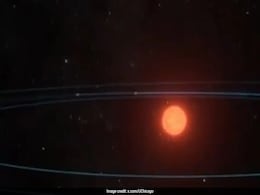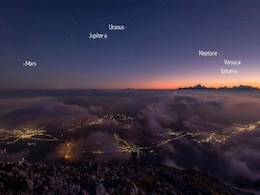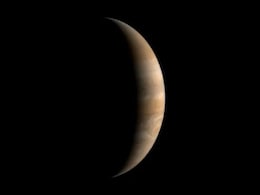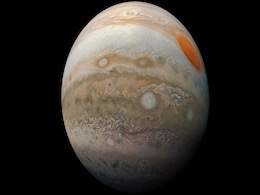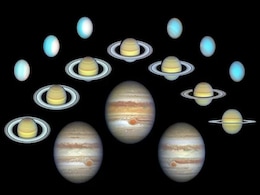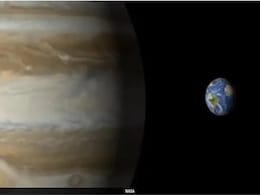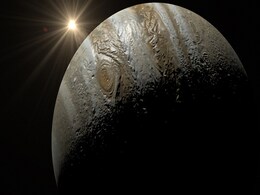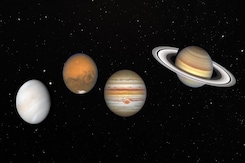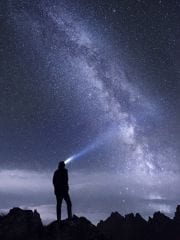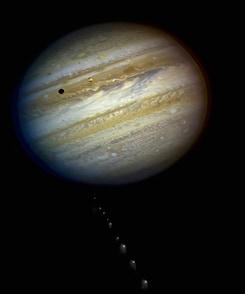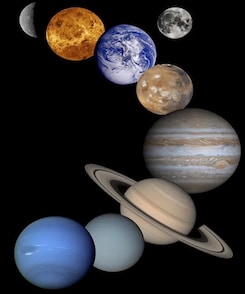Jupiter Planet
- All
- News
- Videos
- Web Stories
-

NASA's Webb Captures First Direct Images Of Carbon Dioxide Outside Solar System
- Tuesday March 18, 2025
- Science | Edited by Ritu Singh
This finding provides compelling evidence that the giant planets in HR 8799 formed through core accretion, a process similar to the formation of Jupiter and Saturn.
-
 www.ndtv.com
www.ndtv.com
-

4 Small Planets Found Around One of Closest Stars To Earth: What We Know
- Saturday March 15, 2025
- World News | The Conversation
Diminutive Barnards Star is closer in size to Jupiter than to the Sun. Only the three stars that make up the Alpha Centauri system lie closer to us.
-
 www.ndtv.com
www.ndtv.com
-

A Fourth 'Mysterious' Form Of Water That Could Form On Alien Planets Observed
- Saturday March 8, 2025
- Science | Edited by Abhinav Singh
Even the icy planets in our solar system such as Neptune, Uranus or Jupiter's moon Europa, might have harboured plastic ice VII.
-
 www.ndtv.com
www.ndtv.com
-

Rare Seven-Planet Alignment 2025: How to Watch in India, Best Viewing Tips
- Monday February 24, 2025
- Written by Gadgets 360 Staff
A rare celestial event featuring seven planets—Mercury, Venus, Mars, Jupiter, Saturn, Uranus, and Neptune—aligning along the ecliptic will be visible in 2025. The alignment starts on February 28, with the best viewing in India on March 3. Venus and Jupiter will be easily visible, while Uranus and Neptune will require a telescope. Experts sugges...
-
 www.gadgets360.com
www.gadgets360.com
-

Exoplanet WASP-121 b’s Atmosphere Features Iron Rains, Jet Streams, and More
- Thursday February 20, 2025
- Written by Gadgets 360 Staff
Astronomers have uncovered extreme weather patterns on WASP-121 b, a gas giant 900 light-years from Earth. The planet experiences iron rain, with metals vaporizing on its scorching dayside and condensing into liquid at night. Supersonic winds carry elements across its atmosphere, forming powerful jet streams. Using the Very Large Telescope, researc...
-
 www.gadgets360.com
www.gadgets360.com
-

February 2025 Planet Parade: How to See Five Planets Align in the Sky
- Wednesday February 5, 2025
- Written by Gadgets 360 Staff
A rare celestial event will unfold in February 2025, with five bright planets—Venus, Jupiter, Mars, Mercury, and Saturn—visible in the evening sky. The highlight occurs on February 24, when Mercury and Saturn appear closest. Uranus and Neptune can also be observed with telescopes. Best viewing conditions require a clear west-southwest horizon a...
-
 www.gadgets360.com
www.gadgets360.com
-

Mysterious Interstellar Object Might Have Shifted Four Planets’ Paths, Study Finds
- Thursday January 30, 2025
- Written by Gadgets 360 Staff
A mysterious interstellar object, estimated to be eight times the mass of Jupiter, may have significantly altered the orbits of Jupiter, Saturn, Uranus, and Neptune billions of years ago. A study suggests that this body passed remarkably close to the Sun, potentially influencing planetary trajectories. Simulations conducted by researchers indicate ...
-
 www.gadgets360.com
www.gadgets360.com
-

Planetary Parade 2025: How And Where To See This Rare Celestial Event In India
- Saturday January 25, 2025
- Science | Edited by Bhavya Sukheja
Stargazers are in or a treat as six planets - Venus, Mars, Jupiter, Saturn, Neptune, and Uranus - are set to align in the night sky today, January 25, offering a spectacular view.
-
 www.ndtv.com
www.ndtv.com
-

Interstellar Object Could Have Shifted Trajectories of Four Planets, New Research Shows
- Tuesday January 21, 2025
- Written by Gadgets 360 Staff
A recent study suggests that an interstellar object, possibly as massive as eight times Jupiter, may have passed through the solar system billions of years ago, significantly altering the orbits of its outer planets—Jupiter, Saturn, Uranus, and Neptune. Using computer simulations, researchers found that in about 1% of the scenarios, such a close ...
-
 www.gadgets360.com
www.gadgets360.com
-

Amateur Astronomer Discovers Unexpected Composition of Jupiter’s Clouds
- Saturday January 11, 2025
- Written by Gadgets 360 Staff
Recent observations by an amateur astronomer reveal that Jupiter’s clouds may not consist of ammonia ice as previously assumed. Using a technique called band-depth analysis, Steve Hill mapped ammonia concentrations in the planet’s atmosphere, finding reflective layers deeper than expected. These findings suggest the clouds may be composed of am...
-
 www.gadgets360.com
www.gadgets360.com
-

Ammonium Hydrosulfide Identified as Primary Component of Jupiter’s Clouds, Not Ammonia
- Wednesday January 8, 2025
- Written by Gadgets 360 Staff
Jupiter’s clouds, long believed to be made of ammonia ice, are now confirmed to consist primarily of ammonium hydrosulfide combined with photochemical materials. This groundbreaking discovery, achieved through collaboration between amateur and professional astronomers, has redefined our understanding of the planet's atmosphere. Using innovative m...
-
 www.gadgets360.com
www.gadgets360.com
-

Hubble Telescope Documents 10 Years of Dramatic Changes on Outer Planets
- Friday December 13, 2024
- Written by Gadgets 360 Staff
NASA’s Hubble Telescope has tracked atmospheric and seasonal changes on Jupiter, Saturn, Uranus, and Neptune over ten years. Key findings include shifts in Jupiter’s Great Red Spot, Saturn’s seasonal phenomena, Uranus’ polar brightness, and Neptune’s storm activity. These insights, part of NASA’s Outer Planet Atmospheres Legacy (OPAL) p...
-
 www.gadgets360.com
www.gadgets360.com
-

Earth Aligns Between Sun And Jupiter For Spectacular December 7 Event
- Thursday December 5, 2024
- Science | Edited by Nikhil Pandey
On December 7, Earth will align between the Sun and Jupiter, creating a rare astronomical event known as Jupiters opposition.
-
 www.ndtv.com
www.ndtv.com
-

Jupiter’s Earth-Sized Storms Might Be Caused by Magnetic Tornadoes, Study Claims
- Wednesday November 27, 2024
- Written by Gadgets 360 Staff
Magnetic tornadoes twisting down from Jupiter's ionosphere create massive, Earth-sized anticyclonic storms in the planet's atmosphere. These dark ovals, detectable only in ultraviolet light, form dense hazes of aerosols stirred by swirling magnetic vortices. This phenomenon, visible at Jupiter's poles, was unveiled through data from the Hubble Spac...
-
 www.gadgets360.com
www.gadgets360.com
-

Super-Earth In the Solar System Could Have Rendered Our Planet Uninhabitable, Says Study
- Wednesday November 27, 2024
- Written by Gadgets 360 Staff
A recent study explores a hypothetical super-Earth between Mars and Jupiter, revealing its severe impact on Earth's orbit and climate. Conducted by Florida Institute of Technology scientists Emily Simpson and Howard Chen, the simulation demonstrates how such a planet’s gravity could destabilise neighbouring planets, causing erratic orbits and ext...
-
 www.gadgets360.com
www.gadgets360.com
-

NASA's Webb Captures First Direct Images Of Carbon Dioxide Outside Solar System
- Tuesday March 18, 2025
- Science | Edited by Ritu Singh
This finding provides compelling evidence that the giant planets in HR 8799 formed through core accretion, a process similar to the formation of Jupiter and Saturn.
-
 www.ndtv.com
www.ndtv.com
-

4 Small Planets Found Around One of Closest Stars To Earth: What We Know
- Saturday March 15, 2025
- World News | The Conversation
Diminutive Barnards Star is closer in size to Jupiter than to the Sun. Only the three stars that make up the Alpha Centauri system lie closer to us.
-
 www.ndtv.com
www.ndtv.com
-

A Fourth 'Mysterious' Form Of Water That Could Form On Alien Planets Observed
- Saturday March 8, 2025
- Science | Edited by Abhinav Singh
Even the icy planets in our solar system such as Neptune, Uranus or Jupiter's moon Europa, might have harboured plastic ice VII.
-
 www.ndtv.com
www.ndtv.com
-

Rare Seven-Planet Alignment 2025: How to Watch in India, Best Viewing Tips
- Monday February 24, 2025
- Written by Gadgets 360 Staff
A rare celestial event featuring seven planets—Mercury, Venus, Mars, Jupiter, Saturn, Uranus, and Neptune—aligning along the ecliptic will be visible in 2025. The alignment starts on February 28, with the best viewing in India on March 3. Venus and Jupiter will be easily visible, while Uranus and Neptune will require a telescope. Experts sugges...
-
 www.gadgets360.com
www.gadgets360.com
-

Exoplanet WASP-121 b’s Atmosphere Features Iron Rains, Jet Streams, and More
- Thursday February 20, 2025
- Written by Gadgets 360 Staff
Astronomers have uncovered extreme weather patterns on WASP-121 b, a gas giant 900 light-years from Earth. The planet experiences iron rain, with metals vaporizing on its scorching dayside and condensing into liquid at night. Supersonic winds carry elements across its atmosphere, forming powerful jet streams. Using the Very Large Telescope, researc...
-
 www.gadgets360.com
www.gadgets360.com
-

February 2025 Planet Parade: How to See Five Planets Align in the Sky
- Wednesday February 5, 2025
- Written by Gadgets 360 Staff
A rare celestial event will unfold in February 2025, with five bright planets—Venus, Jupiter, Mars, Mercury, and Saturn—visible in the evening sky. The highlight occurs on February 24, when Mercury and Saturn appear closest. Uranus and Neptune can also be observed with telescopes. Best viewing conditions require a clear west-southwest horizon a...
-
 www.gadgets360.com
www.gadgets360.com
-

Mysterious Interstellar Object Might Have Shifted Four Planets’ Paths, Study Finds
- Thursday January 30, 2025
- Written by Gadgets 360 Staff
A mysterious interstellar object, estimated to be eight times the mass of Jupiter, may have significantly altered the orbits of Jupiter, Saturn, Uranus, and Neptune billions of years ago. A study suggests that this body passed remarkably close to the Sun, potentially influencing planetary trajectories. Simulations conducted by researchers indicate ...
-
 www.gadgets360.com
www.gadgets360.com
-

Planetary Parade 2025: How And Where To See This Rare Celestial Event In India
- Saturday January 25, 2025
- Science | Edited by Bhavya Sukheja
Stargazers are in or a treat as six planets - Venus, Mars, Jupiter, Saturn, Neptune, and Uranus - are set to align in the night sky today, January 25, offering a spectacular view.
-
 www.ndtv.com
www.ndtv.com
-

Interstellar Object Could Have Shifted Trajectories of Four Planets, New Research Shows
- Tuesday January 21, 2025
- Written by Gadgets 360 Staff
A recent study suggests that an interstellar object, possibly as massive as eight times Jupiter, may have passed through the solar system billions of years ago, significantly altering the orbits of its outer planets—Jupiter, Saturn, Uranus, and Neptune. Using computer simulations, researchers found that in about 1% of the scenarios, such a close ...
-
 www.gadgets360.com
www.gadgets360.com
-

Amateur Astronomer Discovers Unexpected Composition of Jupiter’s Clouds
- Saturday January 11, 2025
- Written by Gadgets 360 Staff
Recent observations by an amateur astronomer reveal that Jupiter’s clouds may not consist of ammonia ice as previously assumed. Using a technique called band-depth analysis, Steve Hill mapped ammonia concentrations in the planet’s atmosphere, finding reflective layers deeper than expected. These findings suggest the clouds may be composed of am...
-
 www.gadgets360.com
www.gadgets360.com
-

Ammonium Hydrosulfide Identified as Primary Component of Jupiter’s Clouds, Not Ammonia
- Wednesday January 8, 2025
- Written by Gadgets 360 Staff
Jupiter’s clouds, long believed to be made of ammonia ice, are now confirmed to consist primarily of ammonium hydrosulfide combined with photochemical materials. This groundbreaking discovery, achieved through collaboration between amateur and professional astronomers, has redefined our understanding of the planet's atmosphere. Using innovative m...
-
 www.gadgets360.com
www.gadgets360.com
-

Hubble Telescope Documents 10 Years of Dramatic Changes on Outer Planets
- Friday December 13, 2024
- Written by Gadgets 360 Staff
NASA’s Hubble Telescope has tracked atmospheric and seasonal changes on Jupiter, Saturn, Uranus, and Neptune over ten years. Key findings include shifts in Jupiter’s Great Red Spot, Saturn’s seasonal phenomena, Uranus’ polar brightness, and Neptune’s storm activity. These insights, part of NASA’s Outer Planet Atmospheres Legacy (OPAL) p...
-
 www.gadgets360.com
www.gadgets360.com
-

Earth Aligns Between Sun And Jupiter For Spectacular December 7 Event
- Thursday December 5, 2024
- Science | Edited by Nikhil Pandey
On December 7, Earth will align between the Sun and Jupiter, creating a rare astronomical event known as Jupiters opposition.
-
 www.ndtv.com
www.ndtv.com
-

Jupiter’s Earth-Sized Storms Might Be Caused by Magnetic Tornadoes, Study Claims
- Wednesday November 27, 2024
- Written by Gadgets 360 Staff
Magnetic tornadoes twisting down from Jupiter's ionosphere create massive, Earth-sized anticyclonic storms in the planet's atmosphere. These dark ovals, detectable only in ultraviolet light, form dense hazes of aerosols stirred by swirling magnetic vortices. This phenomenon, visible at Jupiter's poles, was unveiled through data from the Hubble Spac...
-
 www.gadgets360.com
www.gadgets360.com
-

Super-Earth In the Solar System Could Have Rendered Our Planet Uninhabitable, Says Study
- Wednesday November 27, 2024
- Written by Gadgets 360 Staff
A recent study explores a hypothetical super-Earth between Mars and Jupiter, revealing its severe impact on Earth's orbit and climate. Conducted by Florida Institute of Technology scientists Emily Simpson and Howard Chen, the simulation demonstrates how such a planet’s gravity could destabilise neighbouring planets, causing erratic orbits and ext...
-
 www.gadgets360.com
www.gadgets360.com


